![]()
![]()
![]()
Use LEFT and RIGHT arrow keys to navigate between flashcards;
Use UP and DOWN arrow keys to flip the card;
H to show hint;
A reads text to speech;
75 Cards in this Set
- Front
- Back
|
What do all Circulatory Systems consist of? |
Blood, a heart and blood vessels |
|
|
Types of Circulatory Systems |
Open and Closed |
|
|
Describe an Open Circulatory System |
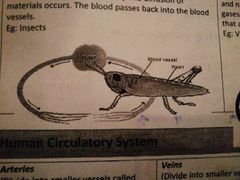
Blood is pumped into open ended blood vessels + comes into contact with the cells. Blood surrounds cells + diffusion occurs. Blood passes back into blood vessels. e.g. Insects |
|
|
Describe a Closed Circulatory System |
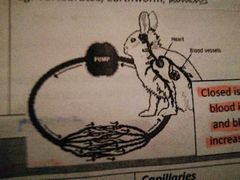
Blood remains enclosed in blood vessels. Blood doesn't come into contact with cells. Diffusion of gas + nutrients occurs as capillary walls are thin allowing gases to diffuse into the tissue fluid (fluid around cells allows gases to be exchanged) e.g. Vertebrates, earthworm, humans |
|
|
Why are closed circulatory systems more efficient? |
Blood is pumped faster and blood flow can be increased or decreased |
|
|
What are Arterioles? |
Smaller vessels divided from arteries |
|
|
What are Venules? |
Smaller vessels divided from veins |
|
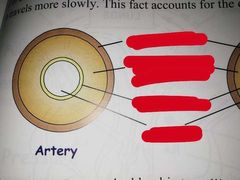
Structure of Arteries |
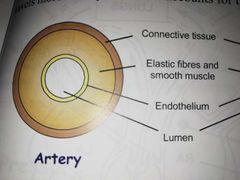
- Thick elastic muscle wall - Small lumen (where blood flows through) - No valves |
|
|
Describe Blood Flow of Arteries |
- Carry blood AWAY from heart - Blood flow rapid so under HIGH PRESSURE |
|
|
Type of Blood in Artery |
Carries oxygenated blood (except in pulmonary artery) |
|
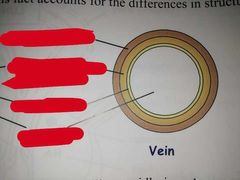
Structure of Vein |
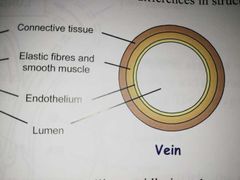
- Thin muscle wall - Large lumen - Valves present (prevents backflow of blood) |
|
|
Describe Blood Flow in veins |
- Carry blood TOWARDS the heart - Blood flow is slow so under low pressure |
|
|
Type of Blood in Veins |
Carries de oxygenated blood (except in pulmonary vein) |
|
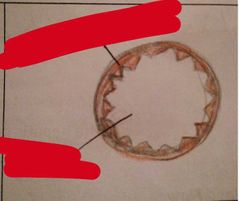
Structure of Capillaries |
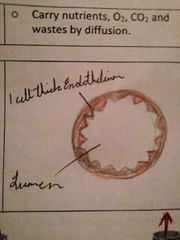
- Wall is 1 cell thick (endothelium) - Small lumen - No valves |
|
|
Describe Blood Flow in Capillaries |
- Low pressure as connects arteriole and venule |
|
|
Type of Blood in Capillaries |
Carry nutrients, oxygen, carbon dioxide and wastes by diffusion |
|
|
Describe Gas Exchange at Capillary |
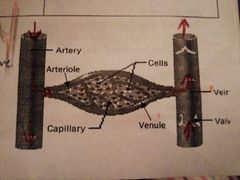
- Arteries carry blood rich in oxygen and food from heart - At capillaries: > Food + oxygen leave blood + enter cells > CO2 + waste leaves cells + enter blood - Veins carry blood rich in CO2 + waste back to heart (Artery > Arteriole > Capillary > Venule > Vein) |
|
|
Adaptations of the Capillary for Function |
- 1 cell thick - Large surface area - Large number of capillaries increases blood flow - Small lumen which slows down movement to allow gas exchange |
|
|
Define Double Circulation |
Having 2 circulatory systems |
|
|
Types of Circulatory Systems in Humans |
Pulmonary and Systemic |
|
|
Describe Pulmonary Circulation |
Blood is pumped to heart > lungs > heart |
|
|
Describe Systemic Circulation |
Blood is pumped to heart > body > heart |
|
|
Advantages of Double Circulation |
- Keeps oxygenated + deoxygenated blood separate - Make sure there is enough blood pressure in all parts of the body |
|
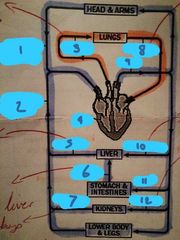
|
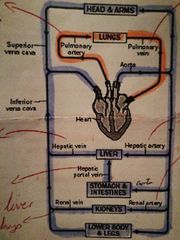
|
|
|
Blood vessel that enters lungs |
Pulmonary artery |
|
|
Blood vessel that leaves lungs to enter heart |
Pulmonary vein |
|
|
Blood vessel that leaves liver |
Hepatic vein |
|
|
Blood vessel that enters liver |
Hepatic artery |
|
|
Blood vessel that connects intestine to liver |
Hepatic Portal Vein |
|
|
Blood vessel that leaves kidneys |
Renal vein |
|
|
Blood vessel that enters kidney |
Renal artery |
|
|
Where does portal system begin and end? |
In capillaries |
|
|
Adaptation of Blood vessels during exercise or change in emotions (e.g. Nervous) |
Muscles + elastic fibres in blood vessels can change in size to allow blood to flow. Increase in blood flow near skin allows us to cool down. After, elastic fibres bring blood vessels back to normal shape. |
|
|
Define Blood pressure |
Thee force blood exerts against wall of blood vessel |
|
|
Where is blood pressure highest + lowest (blood vessels) ? |
Highest in arteries + lowest in veins |
|
|
Function of valves |
Prevent backflow of blood |
|
|
Location of Heart |
Left side of chest, between lungs in thoracic cavity, behind the sternum (breast bone) inside ribcage above diaphragm |
|
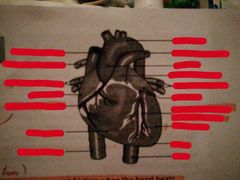
|

|
|
|
Muscle heart is made of |
Cardiac muscle (never tires) |
|
|
What is the Pericardium? |
Fluid membrane that surrounds heart to prevent friction when heart beats |
|
|
What is the Septum? |
Separates right + left halves of heart |
|
|
Chambers in each half of heart, separated by a valve |
Atrium and ventricle |
|
|
What are the AV Valves? |
Atrio-Ventricular valves: tricuspid valve on right, bicuspid valve on left |
|
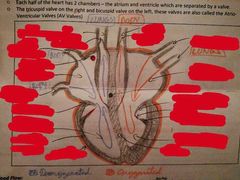
|
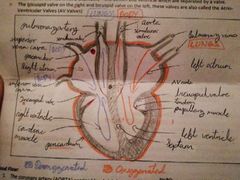
|
|
|
Blood vessel that carries blood rich in nutrients + O2 away from the heart |
Coronary artery (aorta) |
|
|
Blood vessel that carries blood rich in waste + CO2 to the heart |
Coronary vein (vena cava) |
|
|
Function of atria + ventricles |
Atria: receive blood Ventricles: pump blood |
|
|
Why is left ventricle thicker than right ventricle? |
Left ventricle must pump blood around body whereas right ventricle pumps blood to lungs |
|
|
Function of semilunar valves |
Prevent backflow of blood into heart |
|
|
What controls opening and closing of valves? |
Tissue like thread Chordae Tendinae + Papillary muscles |
|
|
What blood vessel supplies heart with blood? |
Coronary/cardiac artery |
|
|
Where does coronary artery begin? |
Where aorta leaves heart |
|
|
Where does coronary vein empty? |
Into vena cava |
|
|
Define Systole |
Heart muscles contract |
|
|
Define Diastole |
Heart muscles relax |
|

Describe the Process of the Cardiac Cycle (Stages of Heartbeat) |

1. Blood enters both atria. Bicuspid + tricuspid valves are closed. 2. Pressure inside atria increases as blood enters, causing valves into ventricles to open. 3. Atria contract (systole) to force remaining blood into ventricles 4. Ventricles contract (systole) + atria relax (diastole) 5. Pressure causes tricuspid + bicuspid valve to close (1st sound of heartbeat) 6. Ventricles contracting causes pressure against semilunar valves + open forcing blood into aorta + pulmonary artery 7. Ventricles relax (diastole) + semilunar valves close to prevent backflow of blood = 2nd sound of heartbeat |
|
|
What is a Pacemaker? |
Knot of muscle that controls heartbeat |
|
|
What does SA node stand for? |
Sinoatria Node (Pacemaker) |
|
|
Location of pacemaker |
Top wall of right atrium between vena cava and pulmonary artery |
|
|
Function of Pacemaker |
Generates electrical impulse, causes atria to contract, controls heart rate |
|
|
Function of AV node |
Controls heart rate, generates electrical impulses, causes ventricles to contract |
|
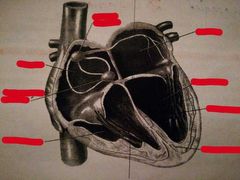
|
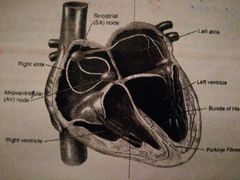
|
|
|
Define Pulse and how can it be detected? |
Contraction of the artery walls as aorta expands after contraction of left ventricle. Can be checked on wrist or neck. |
|
|
How is blood pressure measured? |
Taken from an artery in upper arm. This measures amount of pressure required to stop blood flow through artery. Region of highest blood pressure (left ventricular systole) and region of lowest blood pressure (ventricular diastole) is measured. |
|
|
Average human heartbeat |
72 beats per minute |
|
|
What makes the Lub sound (1st)? |
Closing of tricuspid + bicuspid valves |
|
|
What makes the Dub sound (2nd)? |
Semi-lunar valves closing |
|
|
Average human blood pressure |
120/80 |
|
|
Define Hypertension |
High blood pressure |
|
|
Define Hypotension |
Low blood pressure |
|
|
Effect of exercise on heart |
- Improves muscle strength - Improves oxygen supply - Reduces blood pressure |
|
|
Effects of Diet on Heart |
- Too much cholesterol restricts blood flow to heart causing blockage - Blockage in coronary artery causes heart attack - Blockage in artery in brain causes stroke - Clogged arteries increase blood pressure |
|
|
Effects of Smoking in Heart |
- Nicotine increases blood pressure + blood cholesterol levels - Carbon monoxide in cigarette smoke prevents oxygen transfer to cells, straining heart - Increases risk of blood clots causing heart attack + stroke |
|
|
Location of AV node |
In the septum near tricuspid valve |
|
|
Tools used to dissect heart |
Scalpel and seeker |

